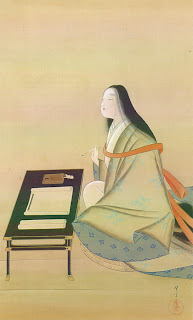Saturday, October 13, 2012
About the Author
Murasaki Shikibu was born in 973 C.E. into the Fujiwara family during Japan's Heian Period. Daughter of a scholar and province governor, she was always very intelligent. Lady Murasaki, unlike many Japanese women, was fluent in Chinese and had learned Chinese classics, though it was considered improper at the time for women in Japan to do so. After giving birth to her only daughter in 999 C.E. and becoming a widow in 1001 C.E., Murasaki Shikibu was brought to the imperial court to serve as lady-in-waiting to Empress Shoshi because of her known intelligence and writing abilities. Lady Murasaki's best known works include The Tale of Genji and a diary she kept while serving in the imperial court titled, Diary of Lady Murasaki. Lady Murasaki is said to have died in either 1014 C.E. or 1025 C.E.
Monday, October 8, 2012
Demography and Technological Development (Jenne-Jeno, West Africa)
Jenne-Jeno covered
about 25 acres and had a population between 7,000 and 10,000 people.
Iron metallurgy was
an important technology in Jenne-Jeno since it was such a major part in its
economy. There are no written documents that mention Jenne-Jeno by name until
the mid-fifteenth century, which suggests that they had no written language.
Economics (Jenne-Jeno, West Africa)
The Niger River provided nutrients for successful farming, as well as clay for pottery, but iron, which was important since the economy of Jenne-Jeno thrived on iron metallurgy, had to be imported. The people of Jenne-Jeno traded grain, fish, and meats in return for salt, iron, and copper. Jenne-Jeno was an important center for trade. Boats were used to travel the Niger and donkeys were used to travel by land during long distance trade.
Social and Political Developments (Jenne-Jeno, West Africa)
Before the middle of the fifth century CE, there
were little to no social organizational changes. The people of Jenne-Jeno lived
in small settlements, separated by occupations, centered on a middle city. The
city functioned in equality except segregated occupational groups that often
intermarried. Jenne-Jeno was run very differently from most other places,
without political authority or warfare.
Sunday, October 7, 2012
Art (Jenne-Jeno, West Africa)
Geography (Jenne-Jeno, West Africa)
The ancient city of Jenne-Jeno was located along the Niger River south of Timbuktu in present day Mali. The areas near the river that were subject to flooding, or the floodplain, were very suitable for farming.
Subscribe to:
Posts (Atom)






